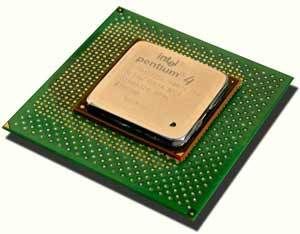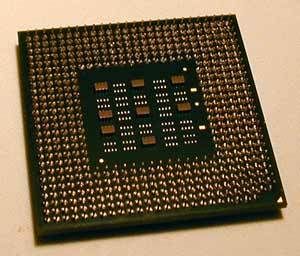Intel's Strike Force: 19 DDR-Motherboards With 845 Chipset and DDR-Support
GHz-Mania: Which P4 Processor?
There is a vast selection of Pentium 4 CPUs available: Willamette core, Northwood core, Socket 423 and Socket mPGA478. Socket 423 has been dying for months, so don't go for these systems. First of all, they do not support the new Northwood core, and secondly, there will be no processors faster than 2 GHz for this socket. As far as we know, there are no motherboards with socket 423 and DDR available, so you shouldn't be in danger of getting one of these.

That's the 'old' Pentium 4 for Socket 423. Do not get this oldie!

That's what the current Pentium 4 looks like (mPGA478). The models with Willamette and Northwood cores can only be distinguished by reading the L2 cache size on the heat spreader label.

That's the bottom of the Pentium 4.
In contrast to some of the processors from AMD, the Pentium 4 has never been cheap. That's why we strongly recommend that you shell out a larger sum only if you expect some return on your investment. In everyday life, there is hardly any difference between a Pentium 4 1.8 GHz and the 2 GHz model. Still, the top models are quite interesting if you want to do video encoding or other performance-eating tasks - or if the cost factor is secondary for you.
The 2 GHz model is still priced at a minimum of $325. It seems more reasonable to purchase a model between 1.6 and 1.9 GHz and upgrade the system with one of the future CPUs in several months (2.2 to 2.5 GHz) - at prices that will be much more attractive.
An exception is the latest P4 with Northwood core. Thanks to its 0.13 µm structures, practically all CPUs run safely at 2.5 GHz or even more. Some weeks ago, we were even able to run such a processor at above 3 GHz ! For those who can afford spending a lot of money, the new core with 512 kB L2 cache is the one to choose.
Stay on the Cutting Edge
Join the experts who read Tom's Hardware for the inside track on enthusiast PC tech news — and have for over 25 years. We'll send breaking news and in-depth reviews of CPUs, GPUs, AI, maker hardware and more straight to your inbox.
Current page: GHz-Mania: Which P4 Processor?
Prev Page What Do You Like Today? Additional Features Next Page Overclocking: If You Do It, Do It Right!Most Popular

